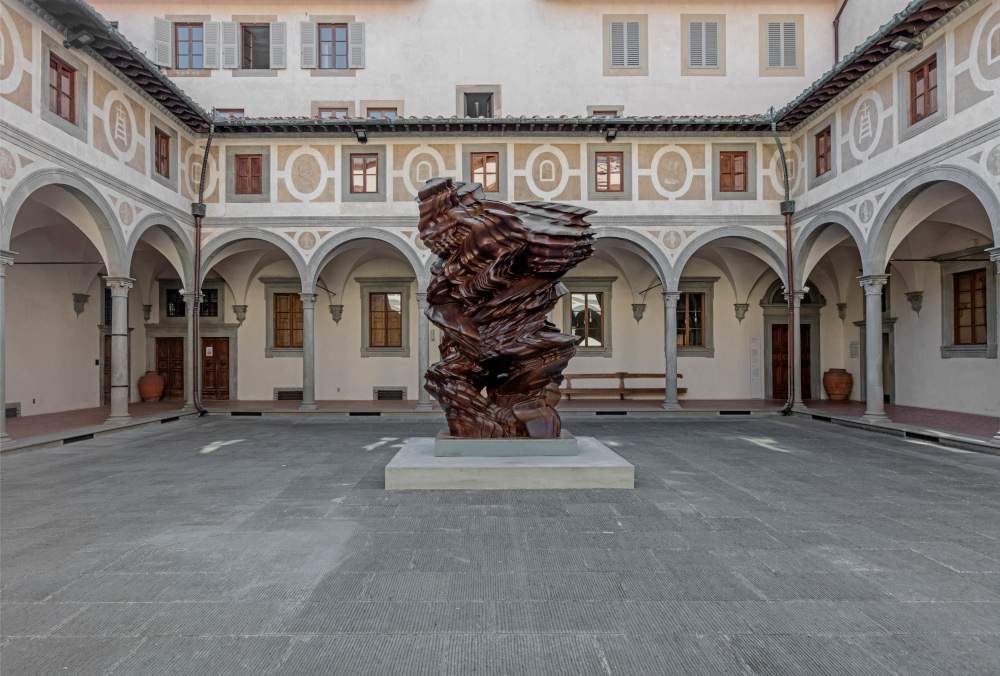From Sept. 22, 2022 to Jan. 15, 2023, on the occasion of Florence Art Week, the Museo Novecento presents the major monographic exhibition of Tony Cragg (Liverpool, 1949) entitled Transfer, curated by Sergio Risaliti and Stefania Rispoli.
On display will be a selection of sculptures and works on paper by the English master, among the leading exponents of international sculpture, known for having contributed to a renewal of plastic language through the introduction of new materials and techniques. Theunprecedented exhibition project is designed to present not only the works (sculptures and drawings), but also the artist’s creative process. Tony Cragg’s entire artistic research can be read as a tribute to the infinite possibilities of form and to that unlimited variety of solutions that only art, together with nature, can evoke.
His earliest works, which can be dated to the late 1970s, stem from theassemblage of common objects such as tools, furniture, small artifacts and discarded materials, and are influenced by the tradition of Duchampian ready-made and Surrealist object trouvé. Later, philosophical studies and scientific research began to influence his practice, leading him to experiment with materials (from bronze to resins, steel to plastic, plaster, wood, glass, domestic to industrial objects, organic to synthetic) and to create sculptures that still combine craftsmanship with technology, often making use of robotics.
In his works, the artist has everything around us as a source of inspiration: from nature with its organic compositions, to the crystalline structures of minerals; from digitally processed images, to artificially created products in the laboratory; from archaeology, to geology; from art history, to biology. “Nature has been producing wonderfully intricate forms and structures for millions of years ... it’s a diversity that fascinates me. We, on the other hand, produce rather simple, repetitive, easily reproducible forms based on simple geometries,” says the artist. The sculptures are generated from a root, a central structure that supports them, from which they unravel to generate many different ramifications, imitating what nature does with its forms. “I want to make work that has the same intense effect on me as looking at Nature. In this sense, I have been fascinated by the way the rational constructions underlying the forms translate into emotional qualities.” In the artistic process, Cragg continually takes, creates, manipulates and distorts form to create semantically ambiguous sculptures that, between abstraction and figuration, can as much evoke articulated natural landscapes, such as fjord inlets, as they can give us the illusion of representing a human figure or a familiar object.
The Transfer exhibition is a tribute to sculpture. The exhibition rooms of the Museo Novecento host a selection of small and medium-sized works along with drawings and watercolors that are intended to give us an idea of his prolific and multifaceted activity. Arranged according to stylistic and formal criteria, the more than 100 works on display reveal a coherence and organicity intrinsic to all of Cragg’s work, presenting an expressive language meticulously constructed over the years based on the idea that the creative process is also a path of discovery. The artist always proceeds in the same way, from drawing to choosing materials, experimenting with technique, and selecting color, working with the material and learning from it and its reactions.
The works located between the ground and second floors of the Museo Novecento are joined for the first time by three monumental sculptures exhibited in the museum’s cloister(Versus, Masks, Spring) and one in the Cortile degli Uomini of the Istituto degli Innocenti(Stack), which dialogue with the architecture of places conceived in the Renaissance as environments dedicated to retreat and meditation.
The rooms on the second floor present numerous drawings conceived as essential and preparatory tools for plastic elaboration, while those on the ground floor recreate the artist’s studio through the layout. In Wuppertal, Germany, where he moved in the late 1970s, Cragg in fact created a design space conceived as a true citadel of art, a scientific laboratory with technicians and craftsmen working simultaneously on several works, testing in workshops the limits and capabilities of techniques and materials. Not far from there in 2008 he founded the Skulpturenpark Waldfrieden, an outdoor sculpture park that displays works by many contemporary artists, including his own, testifying to his continuing dedication to sculpture in the broadest sense.
On the occasion of the exhibition TONY CRAGG. Transfer, admission to the Museo Novecento will be exceptionally free on Thursday, Sept. 22, 2022.
Photo: Museo Novecento
 |
| At the Museo Novecento a major monographic exhibition dedicated to Tony Cragg |
Warning: the translation into English of the original Italian article was created using automatic tools. We undertake to review all articles, but we do not guarantee the total absence of inaccuracies in the translation due to the program. You can find the original by clicking on the ITA button. If you find any mistake,please contact us.